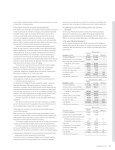
ar2013 43 / 56
10秒後にBOOKのページに移動します
used to hedge interest fluctuation risk present in borrowings, but are not used for speculative or trading purposes. (2) Description of financial instruments and associated risks Notes and accounts receivable, which represent trade receivables, are exposed to client-based credit risk. Furthermore, foreign currency denominated trade receivables are also subject to exchange rate fluctuation risks. In order to counter such risk, foreign currency borrowings are used when necessary as a means of hedging the net position of foreign currency denominated trade payables. Securities and investment securities are primarily negotiable deposits, held-to-maturity securities and shares related to businesses, and are thus exposed to risk stemming from fluctuations in market value. Notes and accounts payable, which represent trade payables, are due within one year. A portion of these are foreign currency denominated items related to payment for raw material imports, which are subject to exchange rate fluctuation risk. These are constantly maintained within the balance of receivables denominated in the same foreign currencies. Borrowings are used to procure funds necessary for operational transactions and capital expenditures. A portion of these borrowings bearing variable interest rates are exposed to interest rate fluctuation risk. Derivative transactions (interest rate swap transactions) are used as a means of hedging. The interest rate swap transactions are entered into in order to hedge against risk associated with fluctuations in interest rates on borrowings. Information on hedge accounting-related matters such as hedging instruments, hedged items, hedging policies and methods of assessing the effectiveness of hedging can be found in Note 2 (m). (3) Risk management systems related to financial instruments (a) Management of credit risk (risk associated with non-performance of a contract by a business partner etc.) The departments in charge of Company operations regularly monitor the trade receivable status of all business partners in accordance with the Regulations on Selling in order to identify business partner-based credit risk associated with the deterioration of financial circumstances or other causes at an early stage and reduce it. In case of the consolidated subsidiaries, their divisions or accounting departments also manage the financial and credit status of their business partners pursuant to their own regulations. Derivative transactions are entered into only with highly rated financial institutions. The maximum credit risk value as of the date of closing of consolidated accounts for the current term is expressed by the value of financial assets in the consolidated balance sheet which are subject to credit risk. (b) Management of market risk (risk associated with exchange rate and interest rate fluctuations) When necessary, the Company uses borrowings denominated in foreign currencies to hedge its foreign currency denominated trade receivables and trade payables. Interest rate swaps are used to reduce risk associated with fluctuations in interest expenses related to borrowings. The Company regularly monitors the fair value of securities and investment securities, and the financial condition of the issuers (its business partners). Derivative transactions are individually approved by the director of finance and accounting before being entered into by the finance and accounting department, and their position and profit/loss situation are managed regularly. (c) Management of liquidity risk associated with procuring funds (the risk of being unable to execute a payment on the due date) The Company and its consolidated subsidiaries have formulated cash flow management plans and manage liquidity risk by, for example, keeping a certain amount of cash reserves on hand. The conclusion of commitment line agreements with a total value of \10 billion also serves to reduce liquidity risk. (4) Supplementary information regarding the fair value of financial instruments The fair value of financial instruments consists of their market price-based value, and, if a market price is not available, their logically calculated value. Variable factors are incorporated into the calculations of the fair value, and different fair values are possible depending on the differing assumptions used. 2. Fair value of financial instruments The fair value and carrying value of financial instruments and the difference between both values are shown below. Financial instruments whose fair value is extremely difficult to determine, are not included in the table below. (Please refer to Note 2.) Millions of yen December 31, 2013 Carrying value Fair value Difference (1) Cash and deposits......................................... \17,029 \17,029 . (2) Notes and accounts receivable............ 43,028 43,028 . (3) Securities and investment securities: Available-for-sale securities.................... 38,884 38,884 . Total assets............................................................... 98,942 98,942 . (1) Notes and accounts payable................. 15,735 15,735 . (2) Short-term bank loans................................ 7,238 7,238 . (3) Long-term debt.............................................. 5,861 5,923 \62 Total liabilities......................................................... \28,834 \28,897 \62 Total derivative transactions.......................... . . . Thousands of U.S. dollars December 31, 2013 Carrying value Fair value Difference (1) Cash and deposits......................................... $161,584 $161,584 . (2) Notes and accounts receivable............ 408,277 408,277 . (3) Securities and investment securities: Available-for-sale securities.................... 368,960 368,960 . Total assets............................................................... 938,821 938,821 . (1) Notes and accounts payable................. 149,307 149,307 . (2) Short-term bank loans................................ 68,682 68,682 . (3) Long-term debt.............................................. 55,612 56,207 $594 Total liabilities......................................................... $273,602 $274,197 $594 Total derivative transactions.......................... . . . Millions of yen December 31, 2012 Carrying value Fair value Difference (1) Cash and deposits......................................... \17,096 \17,096 . (2) Notes and accounts receivable............ 43,434 43,434 . (3) Securities and investment securities: (i) Held-to-maturity securities................. 100 100 \ 0 (ii) Available-for-sale securities.............. 24,977 24,977 . Total assets............................................................... 85,608 85,609 0 (1) Notes and accounts payable................. 14,878 14,878 . (2) Short-term bank loans................................ 6,234 6,234 . (3) Long-term debt.............................................. 5,986 6,031 44 Total liabilities......................................................... \27,099 \27,144 \44 Total derivative transactions.......................... . . . Toagosei Co., Ltd. 41